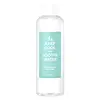What's inside
What's inside
 Key Ingredients
Key Ingredients

 Benefits
Benefits

 Concerns
Concerns

 Ingredients Side-by-side
Ingredients Side-by-side

Water
Skin ConditioningChamaecyparis Obtusa Leaf Extract
Skin ConditioningSodium Chloride
MaskingEthylhexylglycerin
Skin ConditioningScutellaria Baicalensis Root Extract
AstringentThuja Orientalis Extract
AntimicrobialSodium Citrate
BufferingButylene Glycol
Humectant1,2-Hexanediol
Skin ConditioningLonicera Japonica Flower Extract
Skin ConditioningPinus Densiflora Leaf Extract
AntimicrobialHexylene Glycol
EmulsifyingDisodium Cocoamphodiacetate
CleansingForsythia Suspensa Fruit Extract
AntioxidantDisodium EDTA
Bambusa Vulgaris Extract
Skin ConditioningCitric Acid
BufferingDipropylene Glycol
HumectantWater, Chamaecyparis Obtusa Leaf Extract, Sodium Chloride, Ethylhexylglycerin, Scutellaria Baicalensis Root Extract, Thuja Orientalis Extract, Sodium Citrate, Butylene Glycol, 1,2-Hexanediol, Lonicera Japonica Flower Extract, Pinus Densiflora Leaf Extract, Hexylene Glycol, Disodium Cocoamphodiacetate, Forsythia Suspensa Fruit Extract, Disodium EDTA, Bambusa Vulgaris Extract, Citric Acid, Dipropylene Glycol
Water
Skin ConditioningCyclopentasiloxane
EmollientCocos Nucifera Oil
MaskingHexylene Glycol
EmulsifyingCoco-Caprylate/Caprate
EmollientSodium Chloride
MaskingLauryl Methyl Gluceth-10 Hydroxypropyldimonium Chloride
Phenoxyethanol
PreservativePotassium Phosphate
BufferingCaprylyl/Capryl Glucoside
CleansingDisodium EDTA
Ethylhexylglycerin
Skin ConditioningDipotassium Phosphate
BufferingPropanediol
SolventButylene Glycol
HumectantNelumbo Nucifera Flower Extract
Skin ConditioningNelumbo Nucifera Germ Extract
Skin ConditioningTocopherol
Antioxidant1,2-Hexanediol
Skin ConditioningWater, Cyclopentasiloxane, Cocos Nucifera Oil, Hexylene Glycol, Coco-Caprylate/Caprate, Sodium Chloride, Lauryl Methyl Gluceth-10 Hydroxypropyldimonium Chloride, Phenoxyethanol, Potassium Phosphate, Caprylyl/Capryl Glucoside, Disodium EDTA, Ethylhexylglycerin, Dipotassium Phosphate, Propanediol, Butylene Glycol, Nelumbo Nucifera Flower Extract, Nelumbo Nucifera Germ Extract, Tocopherol, 1,2-Hexanediol
Ingredients Explained
These ingredients are found in both products.
Ingredients higher up in an ingredient list are typically present in a larger amount.
1,2-Hexanediol is a synthetic liquid and another multi-functional powerhouse.
It is a:
- Humectant, drawing moisture into the skin
- Emollient, helping to soften skin
- Solvent, dispersing and stabilizing formulas
- Preservative booster, enhancing the antimicrobial activity of other preservatives
Butylene Glycol (or BG) is used within cosmetic products for a few different reasons:
Overall, Butylene Glycol is a safe and well-rounded ingredient that works well with other ingredients.
Though this ingredient works well with most skin types, some people with sensitive skin may experience a reaction such as allergic rashes, closed comedones, or itchiness.
Learn more about Butylene GlycolDisodium EDTA plays a role in making products more stable by aiding other preservatives.
It is a chelating agent, meaning it neutralizes metal ions that may be found in a product.
Disodium EDTA is a salt of edetic acid and is found to be safe in cosmetic ingredients.
Learn more about Disodium EDTAEthylhexylglycerin (we can't pronounce this either) is commonly used as a preservative and skin softener. It is derived from glyceryl.
You might see Ethylhexylglycerin often paired with other preservatives such as phenoxyethanol. Ethylhexylglycerin has been found to increase the effectiveness of these other preservatives.
Hexylene Glycol is a surfactant. Glycols are a class of alcohols. Hexylene Glycol is a surfactant and emulsifier.
As a surfactant, Hexylene Glycol helps gather dirt and oil on your skin to be washed away.
As an emulsifier, Hexylene Glycol helps keep water and oil together. This prevents them from separating in a product. Hexylene Glycol also thins out the texture of a product by lessening viscosity.
Hexylene Glycol has a small molecular weight.
Learn more about Hexylene GlycolChances are, you eat sodium chloride every day. Sodium Chloride is also known as table salt.
This ingredient has many purposes in skincare: thickener, emulsifier, and exfoliator.
You'll most likely find this ingredient in cleansers where it is used to create a gel-like texture. As an emulsifier, it also prevents ingredients from separating.
There is much debate on whether this ingredient is comedogenic. The short answer - comedogenic ratings don't tell the whole story. Learn more about comegodenic ratings here.
The concensus about this ingredient causing acne seems to be divided. Research is needed to understand if this ingredient does cause acne.
Scrubs may use salt as the primary exfoliating ingredient.
Learn more about Sodium ChlorideWater. It's the most common cosmetic ingredient of all. You'll usually see it at the top of ingredient lists, meaning that it makes up the largest part of the product.
So why is it so popular? Water most often acts as a solvent - this means that it helps dissolve other ingredients into the formulation.
You'll also recognize water as that liquid we all need to stay alive. If you see this, drink a glass of water. Stay hydrated!
Learn more about Water